Meena Kumari K1 , Amberkar Mohanbabu Vittalrao1*
, Amberkar Mohanbabu Vittalrao1* , Charitha1, Praveen Kumar SE1,
, Charitha1, Praveen Kumar SE1, and Sushma Prabhath2
and Sushma Prabhath2
1Department. of Pharmacology, Kasturba Medical College, Manipal, Manipal Academy of Higher Education, Manipal-576104.
2Department of Anatomy, Kasturba Medical College, Manipal, Manipal Academy of Higher Education, Manipal-576104.
Corresponding Author Email:-mb.amberkar@manipal.edu
DOI : https://dx.doi.org/10.13005/bpj/2086
Abstract
BACKGROUND -This study undertaken to screen a potential wound healing activity of an ethanolic extract of Anacardiumoccidentale(Ao)leaves in Wistar rats. MATERIALS AND METHODS-Excision wound of 500mm2created on the back of Wistar rats. A total of thirty adult Wistar rats were prescreened and divided into five groups of six rats each.Group I and II rats were treated by normal saline (control) and povidone-iodine (standard drug), respectively. Group III and IV with 0.5% and 2%of Anacardiumoccidentale ointment (test drugs), respectively, and Group V rats treated with anti-wound healer drug dexamethasone, i.m. + 2% Anacardiumoccidentale. All drugs were applied topically except Inj. dexamethasone. In the model of excision wound, the wound healing effect was determined by parameters such as the percentage of wound contraction, duration of epithelialization, and histopathological examination. RESULT-All drugs, povidone-iodine, 0.5%, and 2% of the Ao ointment treated group of rats showed a statistically significant increase (P<0.05) in the % of wound contraction on 5th and 6thdays Vs.Control rats. In contrast,povidone-iodine, 2% Ao ointment and (dexamethasone + 2% Ao)treated rats decreased the period of epithelialization which was statistically significant (P<0.05) compared to the control.However, the standard povidone-iodine treated rats showed a maximum increase in the percentage of wound contraction and minimum period of epithelialization, followed by a higher dose of 2% Ao extract. The plant extract 0.5% and 2% of Ao showeda significant increase inthe rate of wound contraction as compared to the standard drug povidone-iodine also. The combination of (2%Aoextract+dexamethasone) drug-treated rats decreased the rate of wound contraction on 5th, 9th days; whereas, povidone-iodine increased on all days, i.e., 5th, 9th, 13th and 17th days,which was statistically significant (p<0.05) Vs.Normal saline. The povidone and 2% of Ao extract hastened the rate of wound healing activity, which was evident by maximum re-epithelialization and presence of the collagen fibers. CONCLUSION-In our study, the topical application of Anacardiumoccidentale leaf extract has shown promising wound healing activity; however, it failed to reverse the anti-wound healing property of steroids.
Keywords
Anacardiumoccidentale; A Period Of Epithelialization; Povidone-Iodine Wound Contraction
Download this article as:| Copy the following to cite this article: Kumari M. K, Vittalrao A. M, Charitha C, Kumar P. S. E, Prabhath S. Evaluation of Wound Healing Activity of an Ethanolic Extract of Anacardiumoccidentale Leaves in Wistar Rats. Biomed Pharmacol J 2020;13(4). |
| Copy the following to cite this URL: Kumari M. K, Vittalrao A. M, Charitha C, Kumar P. S. E, Prabhath S. Evaluation of Wound Healing Activity of an Ethanolic Extract of Anacardiumoccidentale Leaves in Wistar Rats. Biomed Pharmacol J 2020;13(4). Available from: https://bit.ly/3hivDCp |
Introduction
Wound healing is a complex process. A wound is defined as the breaking of the cellular and anatomic continuity of a tissue [1]. It may be a physical, chemical, thermal, microbial, or immunological injury to the tissue. The rate of wound healing depends upon many factors, including the size of the wound, blood supply to the area, presence of foreign bodies, etc. The treatment of wounds includes the administration of drugs either locally or systematically. Some growth factors, including platelet-derived growth factor, macrophage-derived growth factor, monocyte-derived growth factor, etc. are required to promote wound healing.
Wound healing herbals promote blood coagulation, combat infection, and fasten wound healing. Plants or chemical entities derived from plants need to be explored, identified and formulated for the management of wounds. Various herbal products possessing active ingredients have been used to acceleratethe wound healing process over the years.Anacardiumoccidentale is anevergreen tree,grows to a height of 12 m is highly branched. Its leaves are simple, pale green when young and dark green when mature.2
Cashew tree belongs to the Anacardiaceae family, order -sapindales, genus-Anacardium and species name– Anacardiumoccidentale[2]. The stem, bark, nuts, leaves and cashew apple of Anacardiumoccidentale reveal several medicinal properties like anti-inflammatory, antidiabetic, antibacterial,[3] antifungal and antitumor. Leaves and apple is rich in Vitamin C, organic acids, antioxidant, minerals and carbohydrates[4]. The leaves and bark of the tree relieve toothache, sore gum and it is also used in treating malaria. The leaves have a potential usage for the treatment of psoriasis, eczema, dyspepsia, venereal diseases, cough, bronchitis, intestinal colic, and syphilis like skin disorders[5]. A search of literature revealed that no scientific study on the wound healing property of the plant has been done, thus, the present study was undertaken to evaluate the effect of topical application of an ethanolic extract of leaves of Anacardiumoccidentale(Ao) on the healing of excision wounds in Wistaralbino rats.
Materials and Methods
This study was done after getting approval from the Institutional Animal Ethics Committee, KMC, Manipal (IAEC/KMC/126/2016 dated 16.12.2016).
Chemicals and drugs
Thiopentonesodium (Neon lab ltd), Liquid paraffin wax (Meta Wares India Private Limited, Hyderabad), Eosin, haematoxylinand formalin (Merck Chemicals, Mumbai), ethyl alcohol (Hi- tech Chemicals, Mumbai),povidone-iodine (Win – Medicare),inj. dexamethasone (ZydusAlidac).
Animals
Adult Wistaralbino healthy male rats, locally bred in the Central Animal Research Facility, Manipal, weighing between, 170-200 g were selected for the study. Male rats were used to avoid the confounding effect of estrogen on wound healing. They were maintained under controlled conditions,i.e., temperature (23±2ºC), humidity (50±5%) and 10-12 hours of light and dark cycles. Animals were kept in separate cages (polypropylene) with sterile husk bedding (every alternate day husk and cages were changed), water dispenser, food pellets. Water and food pellets are ad libitum.
Sample collection
Anacardiumoccidentale leaves were collected in Udupi area, Karnataka, India, in the month of November.
Preparation of ethanolic extract of Anacardiumoccidentale leaves
The collected Aoplant leaves were certified by a Botanist, Udupi. Leaves were cleaned with water and dried under shade at room temperature till complete dry. Dried leaves were further processed to powder by using an electrical grinder. The powder in quanta of 60 g each was packed in filter paper, and then it was placed in the Soxhlet extractor chamber for extraction in batches for 8hours with 95% ethanol by reflux condensation at 60-80º C [6]. Following extraction from multiple batches, extract was transferred to a china dish; distillation of the solvent was done. The extract was concentrated on a water bath to syrup consistency at a temperature below 50º C. Later, it was dried and stored in a desiccator.
Preparation of Ointment
The ointment was prepared by using white liquid paraffin wax as a base. Ointment was formulated by grinding base and ethanol extract of leaves of Anacardiumoccidentale in a ceramic mortar with pestle [7]. to get different concentrations on w/w basis.Viz. 0.5% and 2%. The prepared fresh ointment was stored in the plastic airtight container, labelled and maintained at room temperature.
Wound healing Studies
Excision wound experimental paradigm was used to assess the wound healing activity of ethanol extract of leaves of Anacardiumoccidentale.
Experimental design
Table 1: For Experimental Design of Anacardiumoccidentale.
|
Group |
Drug | Route |
No.of animals used |
| Group 1 | Normal saline (Control) | Topical |
6 |
| Group 2 | Povidone-iodine (2%) (Standard) | Topical | 6 |
|
Group 3 |
0.5%Aoextract ointment |
Topical |
6 |
|
Group 4 |
2 %Aoextractointment |
Topical |
6 |
|
Group 5 |
2%Aoointment +Inj. dexamethasone
(0.17mg/kg) |
Topical+ i.m |
6 |
Ao-Anacardiumoccidentale. For the excision model a total of 30 rats were used and divided into 5 groups (n=6 rats).
Excision Wound Healing
Procedure: Rats were anesthetized with inj. thiopentone sodium 30mg/kg intra-peritoneal and its back was shaved after sterilizing with 70% ethanol [8]. An impression was made in the back about 1cm away from the vertebral column and 5cm from the ear. In the impressed wound area the skin was excised to the full thickness about 500mm2 [9].Drug was applied twice daily over the wound. Wound was created on the first day (denoted as day 0) and every alternative day wound measurement (wound contraction) was taken on (1,3,5,7,9,11,13,15,17,19,21) respective days and impression was traced on a paper. Contraction, which mainly contributes for wound closure, was studied by tracing the raw wound area on a transparent paper every alternate day starting from day 0(day of wounding )till 21st postoperative day or till the wound healed completely, whichever occurs earlier.
Measurement of contraction of the wound.
The tracing of the wound was transferred to a one mm2 graph paper to determine the wound area. The wound contraction was calculated as a percentage of the original wound size taken as 100% of each animal in the group by using the equation.
The contraction of the wound was calculated using the formula,
Final statistical analysis was done by taking the mean of individual groups after inducing the wound at 5th,9th, 13th and 17th day.
Epithelialization period was monitored by noting the number of days required for the eschar (Eschar is dead tissue found in a full-thickness wound) to fall off leaving no raw wound area behind [10].
Histopathology
When healing process of wound was complete, rats were subjected to i.v.thiopentone sodium anaesthesia, granulation tissue was obtained using a punch biopsy needle for histopathological examination.
Statistical Analysis
The results were analyzed using one way ANOVA followed by a post hoc test ‘Tukey’. SPSSversion 17 computer software was used to carry out statistical analysis. P value<0.05 was considered as statistically significant.
Results
The percentage of wound contraction was measured on 5th, 9th, 13th, and 17th days of drug treatment to the respective group of rats. On 5th and 9th days; rats treated with povidone-iodine (58.00±0.22 and 80.97±0.39), 0.5% Anacardiumoccidentale extract (49.45±0.28), 2%Ao(54.48±0.32 and 81.13±0.47) showed significant p (<0.05) increase in the percentage of wound contraction vs. control. However, povidone-iodine and 2% Aoshowed a maximum % of wound contraction on the 5th and 9th days, respectively. Rats treated with the (2% Ao+ dexamethasone) combination exhibited the least % of wound contractioni.e. 29.86±0.83 and 43.86±0.46 on 5th and 9th day respectively. The 2% Aoextract treated rats produced relatively a better wound contraction as compared to the 0.5% lower dose. On the 9th day, the percentage of wound contraction showed by the 2% Aotreated rats were as comparable to the povidone-iodine group of rats. On the 13th and 17th days, none of the rats administered with the test drugs produced significant wound contraction vs. control.
The mean period of epithelialization shown by control, standard, 0.5% and 2% test drug-treated rats were 18.30 ± 0.17, 12.33 ± 0.25, 18.19 ± 0.17, 14.14 ± 0.09 days respectively. The mean period of epithelialization with povidone-iodine (12.33 ± 0.25), 2%Anacardiumoccidentale extract (14.14 ± 0.09), and 2%Anacardium occidentale+ dexamethasone (16.20 ± 0.10) were statistically significant p (<0.05) Vs. normal saline. However, the mean period of epithelialization was leastin rats treated with povidone-iodine compared to control. Contrary to the failure of a substantial increase in wound contraction, the combination of (2%Ao+ inj. dexamethasone) treated rats showed a significant decrease in the time taken for full epithelialization Vs. control rats.
Table 2: Effect of ethanolic extract of leaves of Anacardiumoccidentale on the rate of wound contraction in an excision wound.
| Group | Drug (n=6 ) | Wound contraction % Mean ± SEM | |||
| 5th day | 9th day | 13th day | 17th day | ||
| Group 1 | Normal saline (p. o.) | 47.16±0.15 | 73.26±0.84 | 90.93±0.40 | 99.08±0.12 |
| Group 2 | Povidone-iodine(Topical) | 58.00±0.22a | 80.97±0.39a | 91.91±1.02 | 99.35±0.17 |
| Group 3 | AoOintment (0.5%) | 49.45±0.28a,b | 74.62±0.36b | 91.62±0.49 | 98.20±0.21 |
| Group 4 | AoOintment (2%) | 54.48±0.32a,b | 81.13±0.47a | 90.45±0.42 | 99.24±0.09 |
| Group 5 | AoOintment (2%) +inj. dexamethasone | 29.86±0.83a,b | 43.89±0.46a,b | 70.35±0.31a,b | 88.40±0.20a,b |
Values were expressed as Mean ± SEM. Statistical analysis was done using one way ANOVA followed byTukey post hoc test; a p<0.05 Vs control,b p <0.05 Vs standard (povidone iodine), n= No. of rats/gr.
Table 3: Effect of ethanolic extract of leaves of Anacardiumoccidentale on the period of epithelialization in an excision wound.
|
Group (n=6) |
Drug |
Period of epithelialization |
|
Group1 |
Normal saline(PO) | 18.30 ± 0.17 |
|
Group 2
|
Povidone iodine(Topical) | 12.33 ± 0.25a |
|
Group 3
|
Ointment of ethanolic extract of leaves of Ao0.5% | 18.19 ± 0.17b
|
|
Group 4
|
Ointment of ethanolic extract of leaves of Ao2% |
14.14 ± 0.09a,b |
|
Group 5
|
Ointment of ethanolic extract of leaves of Ao2% + dexamethasone | 16.20 ±0.10a,b |
Values were expressed as Mean ± SEM. Statistical analysis was done using one way ANOVA followed by Tukey post hoc test; a p <0.05 Vs control, b p <0.05 Vs standard (povidone iodine), n= No. of rats/gr.
Histopathological Evaluation
Histopathological evaluation was done on the tissue of excision wound obtained by a punch biopsy. The sample were examined under light microscope.
Group 1 (normal saline)
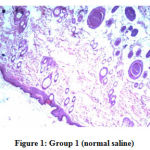 |
Figure 1: (normal saline). |
The collagen fibers are loosely and irregularly placed. The wound site showed delayed re-epithelialization and it was less vascular. The skin appendages, such as hair follicles, are also reduced.
Group 2 (povidone iodine).
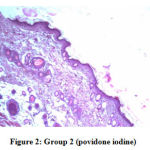 |
Figure 2: (povidone iodine) |
Proper horizontal alignment and interlacement of the dermal fibers, i.e., collagen fibers, are observed. Re-epithelialization is seen almost as normal tissue. The wound site appears more vascular with the presence of hair follicles.
Group 3 (0.5% of ethanolic extract of Anacardiumoccidentale)
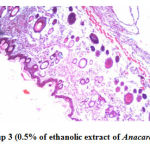 |
Figure 3: (0.5% of ethanolic extract of Anacardiumoccidentale) |
Re-epithelialization and collagen is irregularly arranged. Blood vessels and hair follicles are present.
Group 4 (2% of ethanolic extract of Anacardiumoccidentale)
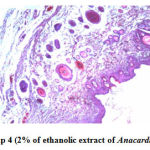 |
Figure 4: (2% of ethanolic extract of Anacardiumoccidentale) |
Re-epithelialization close to normal (thin epithelial layer) and collagen is regularly arranged. Blood vessels and hair follicles are present.
Group 5 (2% of ethanolic extract of Anacardiumoccidentale + dexamethasone)
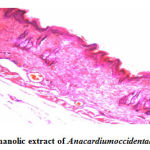 |
Figure 5: (2% of ethanolic extract of Anacardiumoccidentale + dexamethasone) |
Re-epithelialization is not clear/disrupted, however, the arrangement of collagen fibersis seen in a regular order almost like normal structure.
Discussion
Over 50% of all drugs used in the clinical practice are either derivatives or analogs of plant products. Natural Plants and their products comprises of a large storehouse of phyto-biochemical components; theseare non-nutritive metabolite of plants which have antibacterial and antioxidant activity[11]. In recent years, anacardium plants have been trending and continue to get growing attention in the area of therapeutic indigenous plant products. Among the plants of Anacardium, leaf extract Anacardiumoccidentale (cashew apple) is historically used in the treatment of various diseases in tropical America, especially in Northeastern Brazil[12].
To be an active wound healing agent, it should strengthen the process of wound contraction (% of wound contraction) and minimize the time required for re-epithelialization. There is a continuous need for newer and novel agents to have a different mechanism of enhancement of wound healing. Plant products/extracts are relatively better and are devoid of any significant side effects, thence are of choice of better therapeutic agents in hastening the wound healing. Hence, this study was done to evaluate the wound healing property of Anacardiumoccidentaleleaf extract.
A variety of biological properties have been studied, including antimicrobial , antioxidant, antiulcerogenic, anti-fungal, anti-mutagenic, insecticide and anti-inflammatory effects that have attracted the scientific world.In a recent study by Jaiswalet. al. screened ethanolic extract of leaves of A. occidentale for presence of phytochemicals showed that it contain carbohydrates, proteins, catechin (flavonoids), alkaloid. amino acids, tannins and phenolic compounds[13].We used ethanolic extract because; it showed that extractive yield of was found to be higher than aqueous extract, this was due to more ability of ethanol to extract polar as well as non-polar phyto-constituentsIt was found to be significantly rich in catechin (flavonoids);however it was found relatively more in the aqueous extract.Catechin is known to be a bioactive and potent polyphenolic compound[14].
Wound contraction is the process of mobilizing healthy skin around the wound to cover the breached region, involves a complex interplay between well-coordinated cellular function, extracellular matrix, and cytokine interactions. This centripetal wound margin movement is thought to be due to the myofibroblast operation.Collagen is important for strength and structure of wound. Most important step in collagen synthesis is hydroxylation of lysine and proline in the presence of lysyl oxidase enzyme. Though corticosteroids are potent anti-inflammatory agents but generally delay wound healing process by suppressing this enzyme, leading to under hydroxylated collagen, which makes in- capable of generating strong cross links and is easily broken down [15].
Since, rats treated with both the doses of A. occidentale exhibited enhanced wound contraction specially on 5th and 9th days wound healing, it could be because of improved myofibroblast contractile property or increased the number of myofibroblasts recruited into the wound region. However, the wound contraction was maximum with 2% Ao extract and povidone-iodine treated group of rats. Povidone iodine used for many decades as standard pro-wound healing agent primarily because of its plethora of antiseptic, anti-inflammatory, and antioxidant activities. It is a known fact that it acts by inhibiting TNF-α, metalloproteinase and enhances wound healing signals from proinflammatory cytokines by activation of monocytes,T-lymphocytes and macrophages. It is highly effective because it is potent, rapidly acting having all favorable pro-healing actions like broad-spectrum antimicrobial, minimum resistance, efficacy against biofilms, good tolerability, and very robust in excessive inflammation[16].
Epithelialization is the process of restoring the stratified epithelium following injury. Glucocorticoids serve as a barrier to surgical incisions by raising the risk of wound infection and preventing open wound healing as well. Anti-healing mechanism involved because of the fact that these drugs interfere with inflammation, fibroblast proliferation, collagen synthesis and degradation, deposition of connective tissue ground substances, angiogenesis, wound contraction, and re-epithelialization process[17,18].
The excision wound of rats treated with 2% Ao extract and (2% Ao extract +inj. dexamethasone) showed less no. days for complete epithelialization Vs control i.e. 14days and 16 days respectively; however but it was minimum with povidone iodine (12d). Rats treated with 2% Aoand (2% Ao extract +inj. dexamethasone) combination accelerated the period of epithelialization significantly perhaps in the initial and later phases of wound contraction. That means 2% Ao extract is not only effective as stand-alone pro-wound healing agent but also has the ability to overcome the anti-healing impact of steroids.
Oxidative stress is associated with many acute and chronic inflammatory conditions such as wound healing. A. occidentale leaf extract is one of the plants known for presence of active essential phytochemicals like catechin (flavonoids), terpenoids, proteins, tannins and phenolic compounds which impart favorable pro healing activities. For e.g.flavonoids induced signaling pathways are involved in cell migration, especially keratinocytes [19]and also increase the collagen component, whereas glucocorticoids inhibit collagen synthesis.Also flavonoids and phenolic compounds are known as significant plant antioxidants responsible for free radical scavenging of active oxygen species, such as singlet oxygen, superoxide free radicals and hydroxyl radicals. This was attributed to replacement of hydroxyl groups in the aromatic ring systems of the phenolic compounds as a result of their hydrogen donating ability[20]. Our plant also contains Vitamin C[4],which has good antioxidant property and could be responsible for promoting wound healing. It seems that 2% Ao alcoholic extract possesses a plethora of anti-oxidant, anti-septic, anti-inflammatory, and anti-ulcerogenic properties; which collectively has a prohealing effect as shown by the above findings and has been able to accelerate epithelialization either by promoting epithelial cell proliferation or by-local tissue viability similar to povidone-iodine.
2% Anacardiumoccidentale treated rats exhibited lesser number of days for epithelialization Vs. normal saline, It appears that 2% Ao alcoholic extract has prohealing effect as evidenced by the above findings and was able to promote epithelialization either by facilitating the proliferation of epithelial cells or by increasing the viability.
On histopathological examination there was a proper horizontal alignment and interlacement of the dermal fibers, i.e., collagen fibers, are observed. Epithelialization was restored almost as normal tissue. The wound site appears more vascular with the presence of hair follicles. This shows Anacardiumoccidentale leaves possess wound healing property.
Conclusion
We demonstrated from a preclinical study that the topical ethanolicAo extract showed profoundpro-wound healing activity in rats by increasing % of wound contraction, minimizing the period of epithelialization in the excision wound model, and also it was evident histopathologically, that the rats treated with 2% Ao extract showed better wound healing when given along with dexamethasone. It might be suggested for treating various types of wounds in animal and human beings. However, studies are needed to cumulate more in vitro and in vivo evidences co-relating to the Ao leaves phyto-constituents compared to the crude extracts to comprehend the absolute mechanism of wound healing activity.
Limitations
Biochemical parameters need to be included in the study. Still further studies need to be done on wound healing, as when this study was taken there were no studies conducted on leaves of Anacardiumoccidentale for wound healing.
Acknowledgements
Department of Pharmacology,KMC,Manipal
Conflict of interest
Authors declare nil conflict of interest.
Funding Source
This study was supported by department of pharmacology, KMC, Manipal.
References
- Vinay kumar, Abdullah Ahmed Khan, K. Nagarajan. Animal models for the evaluation of wound healing activity.International Bulletin of Drug Research 2013; 3(5): 93-107.
- Orwaetal.Anacardiumoccidentale. Agroforestry data base 4.0, 2009; 1-5.
- Thomas BT, Soladoye MO, Adegboyega TT, Agu GC, Popoola OD. Antibacterial and Anti-Inflammatory Activities of Anacardiumoccidentale Leaves and Bark Extracts. Nigerian Journal of Basic and Applied Sciences. 2015; 23(1):1-6.
CrossRef - SilveiraVanscocelosMirele da et al. Anti-inflammatory and wound healing potential of cashew apple juice (Anacardiumoccidentale) in mice, Experimental biology and medicine. 2015; 240:1648-55.
CrossRef - Silva RubeniceAmaral da et al. Antimicrobial and antioxidant activity of Anacardiumoccidentale L. Flowers in comparison to bark and leaves extract. Journal of biosciences and medicines, 2016; 4:87-99
CrossRef - Rajesh BR, Potty VP, Kumara P, Miranda MT, Sreelekshmy SG. Antioxidant and antimicrobial activity of leaves of Terminalia catappa and Anacardiumoccidentale: A comparative study. Journal of Pharmacognosy and Phytochemistry. 2015 May 1; 4(1):79-82
- Pandey A. Jagtap JV, Patil AA, Joshi RN, Kuchekar BS. Formulation and evaluation antibacterial and antifungal activity of a herbal ointment containing Aloe vera, Azadirachtaindica and Curcuma longa. J Chem Pharm Res 2010; 2(3):182-86
- James O, Victoria IA. Excision and incision wound healing potential of Saba florida (Benth) leaf extract in Rattusnovergicus. Inter J Pharm Biomed Res. 2010; 1(4):101-7.
- Kiran K, Asad M. Wound healing activity of Sesamumindicum L seed and oil in rats. Indian J Exp Biol. 2008; 46(11):777.
- Vowden P. Hard-to-heal wounds made easy. Int Wound J internet.2011 (cited 2016 Aug 18); 2(4):2-6.Available from: http://www.woundsinternational.com/media/issues/514/files/content_10140.pdf
- Desai D, Raorane C, Patil S, Gadgil R and Patkar D. Anacardiumoccidentale: fountain of phytochemicals; the qualitative profiling. World J Pharm Res 2017; 6 (5): 585-592.
CrossRef - Salehi B, Özgüven MG, Kirkin C, Özçelik B, Braga MFB and Carneiro JNP, et al. Antioxidant, Antimicrobial, and Anticancer Effects of Anacardium Plants: An Ethnopharmacological Perspective. Front Endocrinol (Lausanne) 2020; 11: 295.
CrossRef - Jaiswal Y., Naik V., Tatke P., Gabhe S. and Vaidya A. Pharmacognostic And Preliminary Phytochemical Investigations of AnacardiumOccidentale (Linn.) Leaves. Int J Pharm Sci 2012; 4(3): 625-631.
- Jaiswal Y., Tatke P., Gabhe S., Vaidya A., Isolation and quantitative analysis of a bioactive polyphenol – Catechin in AnacardiumoccidentaleLinn. (leaves and testa) by HPLC analysis. Res. J. Pharmacog. Phytochem 2010; 5: 372–376.
- MeenaKumari, Eesha BR, MohanbabuAmberkar, Sarathbabu, Rajshekar, Neelesh Kumar. Wound healing activity of aqueous extract of Crotaloriaverucosa in Wistar rats. Asian Pac J Trop Med 2010; 783-87.
CrossRef - Bigliardi PL, Alsagoff SAL, El-Kafrawi HY, Pyon JK, CheukWa CT, Villa MA Povidone iodine in wound healing: A review of current concepts and practices. Int J Surg 2017; 44: 260-268.
CrossRef - Anstead GM. Steroids, retinoids, and wound healing. Adv Wound Care. 1998; 11(6):277-285.
CrossRef - BernardP.Schimmer and John W .Funder. AdrenocorticotropicHormone, adrenal steroids and the adrenal cortex.In.Brunton LL (ed).The pharmacological basis of therapeutics, 13thedition.USA, Mc Graw – Hill education,2018.852
- Ambiga S, Narayan R, Gowri D, Sukumar D, Madhavan S. Evaluation of wound healing activity of flavonoids from Ipomoea caenea Jacq. AncSci Life 2007; 26(3):45-51
- Formagio ASN, Volobuff CRF, SantiagoM, Cardoso CAL, Carmo Vieira M, Pereira ZV. Antioxidants 2014 Dec; 3(4): 745–757.
CrossRef









